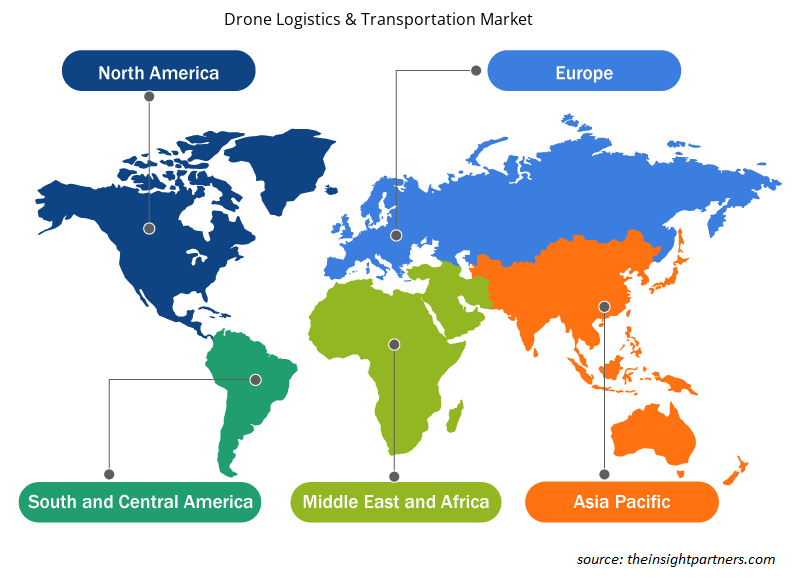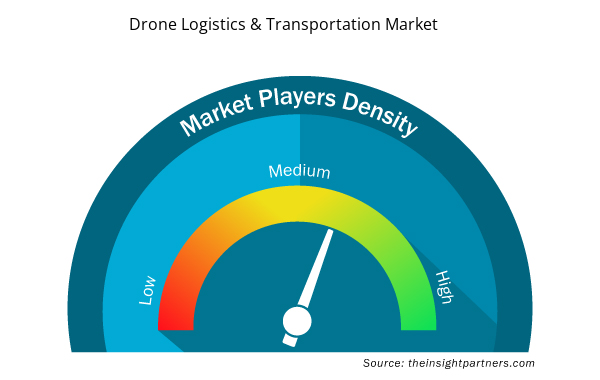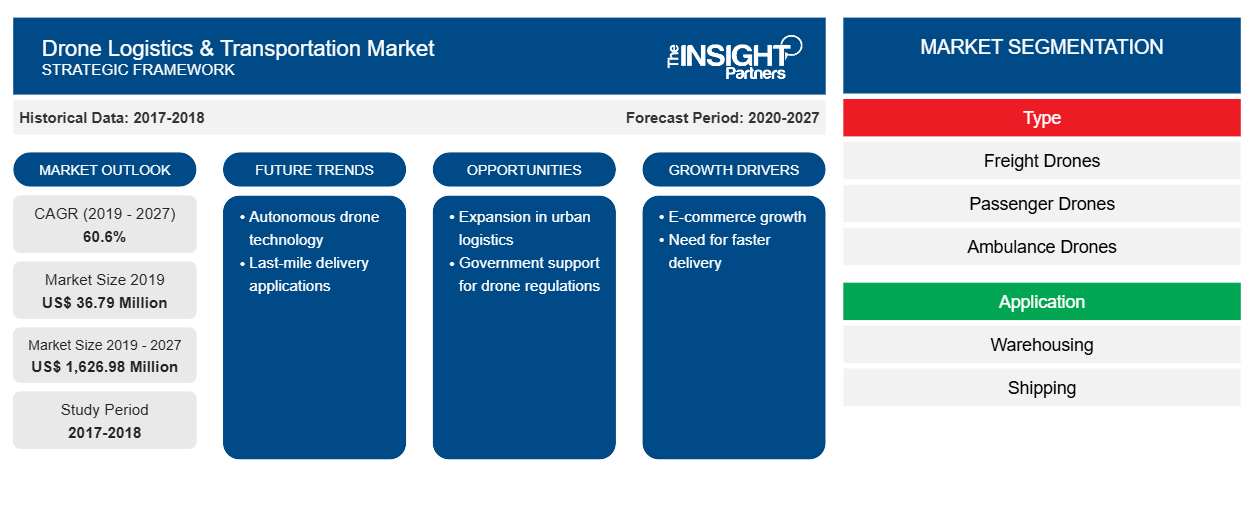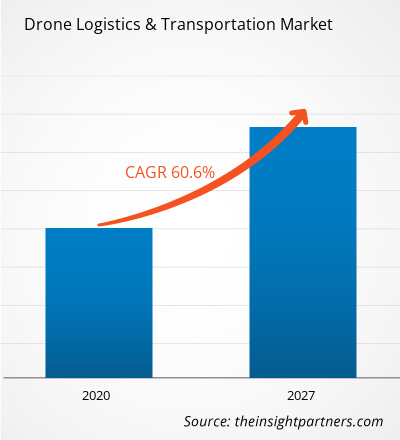2019 年无人机物流和运输市场价值为 3679 万美元,预计到 2027 年将达到 16.2698 亿美元。预计在 2020 年至 2027 年的预测期内,无人机物流和运输市场将以 60.6% 的复合年增长率增长。
在最近的无人机行业中,全球有多家公司正在向不同行业提供第三方服务,以满足他们的交付需求。第三方无人机物流和运输提供商的数量逐年快速增加,这归因于来自最终用户的巨大需求,这有助于无人机物流和运输市场多年来的发展。无人机物流和运输市场是分散的,因为该行业被不同地区的许多中小型参与者所占据。市场参与者不断投入大量资金,为客户提供先进和最优质的无人机物流和运输。当前情况下的无人机物流和运输市场正在取得长足进步,因为几个国家的政府正在简化无人机物流和运输的法律法规,这增加了无人机运营公司的数量。最近,联邦航空管理局简化了通过无人机系统运送货物的规则,这增加了来自不同公司的申请数量。由于严格的立法,航空运输公司被禁止使用该服务。在当前情况下,全球无人机市场的交付部分是利基市场,因为很少有公司提供这项服务。 Zipline 是美国著名的无人机送货服务提供商之一,在非洲运送药品、血液和疫苗。瑞士物流公司 Matternet 致力于通过无人机运送医疗用品,该城市是无人机集中的城市。该公司凭借其技术和在运营城市的业绩记录,已获得美国联邦航空管理局的认可,可在美国测试送货服务。
电子商务领域的不断发展以及由于提供各种好处而不断提高的接受度等因素极大地推动了全球无人机物流和运输市场的发展。然而,缺乏熟练的操作员和操作困难阻碍了市场的增长。农村配送的激增为市场的增长提供了机会。例如,2017 年,坦桑尼亚政府宣布与 Zipline 合作,目的是在该地区提供紧急按需药品、疫苗和血液。
定制此报告以满足您的需求
您可以免费定制任何报告,包括本报告的部分内容、国家级分析、Excel 数据包,以及为初创企业和大学提供优惠和折扣
- 获取此报告的关键市场趋势。这个免费样品将包括数据分析,从市场趋势到估计和预测。
无人机物流和运输市场洞察
由于提供各种福利而接受度不断上升
无人机送货的好处吸引了包裹配送行业参与者和电子商务行业参与者,包括减少道路拥堵、提高安全性、优化路线灵活性、减少温室气体排放以及隔夜或一日送达。由于无人机送货服务大大降低了最终用户的物流成本,预计未来几年市场将通过送货升级。随着法规的进一步修改,以及越来越多的物流合作伙伴和电子商务参与者选择无人机服务,第三方服务提供商的数量预计也会增加,从而在未来几年加剧市场。早些年,一些政府法规限制了无人机用于商业配送目的,然而,随着这些法规的修订,电子商务行业参与者以及一些包裹配送公司正在使用该服务。
基于类型的市场洞察
无人机的应用非常广泛,可以方便快捷地运输包裹。它们被广泛用于运输小件物品、医疗产品,也可以运载乘客。这些无人机根据其用途有自己的飞行限制。无人机既不能在低空飞行,因为会撞到中型和高层建筑,也不能在高空飞行,因为会撞到任何航空公司。航空业规定了它们的飞行限制。在无人机类型的初步分类中,它分为货运无人机、客运无人机和救护无人机。货运无人机进一步细分为货运无人机和送货无人机。
基于应用的市场洞察
配送无人机用于物流和运输行业,使整个包裹配送过程变得轻松便捷。在当前情况下,无人驾驶飞行器(称为无人机)在非军事用途中越来越受欢迎。现在,特别是物流组织正在检查无人机的配送有效性。按应用划分,无人机物流和运输市场由占据最高市场份额的航运部门主导。
无人机物流和运输市场的参与者专注于市场计划、收购和产品发布等策略,以保持其在无人机物流和运输市场中的地位。无人机物流和运输市场主要参与者的一些发展如下:
2019 年 1 月,加拿大无人机配送公司开始对 flacon 进行测试,这是一种新型货物配送无人机,设计行程为 60 公里,起重能力为 50 磅货物。
2019 年 1 月,Flytrex 最近在 B 轮融资中筹集了 750 万美元。该公司获得了 Benhamou Global Ventures (BGV) 的资金以及 btov 的额外投资。借助筹集的资金,它将扩大 Flytrex 在冰岛和北达科他州无人机送货方面的技术和运营。
无人机物流与运输
无人机物流和运输市场区域洞察
Insight Partners 的分析师详细解释了预测期内影响无人机物流和运输市场的区域趋势和因素。本节还讨论了北美、欧洲、亚太地区、中东和非洲以及南美和中美洲的无人机物流和运输市场细分和地理位置。

- 获取无人机物流和运输市场的区域具体数据
无人机物流与运输市场报告范围
| 报告属性 | 细节 |
|---|---|
| 2019 年市场规模 | 3,679万美元 |
| 2027 年市场规模 | 16.2698亿美元 |
| 全球复合年增长率(2019 - 2027) | 60.6% |
| 史料 | 2017-2018 |
| 预测期 | 2020-2027 |
| 涵盖的领域 | 按类型
|
| 覆盖地区和国家 | 北美
|
| 市场领导者和主要公司简介 |
|
无人机物流和运输市场参与者密度:了解其对业务动态的影响
无人机物流和运输市场正在快速增长,这得益于终端用户需求的不断增长,这些需求源于消费者偏好的不断变化、技术进步以及对产品优势的认识不断提高等因素。随着需求的增加,企业正在扩大其产品范围,进行创新以满足消费者需求,并利用新兴趋势,从而进一步推动市场增长。
市场参与者密度是指在特定市场或行业内运营的企业或公司的分布情况。它表明相对于给定市场空间的规模或总市场价值,有多少竞争对手(市场参与者)存在于该市场空间中。
在无人机物流和运输市场运营的主要公司有:
- Cheetah 软件系统公司
- 无人机配送加拿大公司
- 调情
- Flytrex 航空有限公司
- 哈迪斯集团
免责声明:上面列出的公司没有按照任何特定顺序排列。

- 获取无人机物流和运输市场顶级关键参与者概览
无人机物流和运输市场 – 按类型
- 货运无人机
- 货运无人机
- 送货无人机
- 载人无人机
- 救护车无人机
无人机物流和运输市场 – 按应用
- 军队
- 商业的
无人机物流和运输市场 – 按垂直行业划分
- 金融保险业协会
- 卫生保健
- 政府
- 零售
- 制造业
- 其他的
无人机物流和运输市场——按地区划分
北美
- 我们
- 加拿大
- 墨西哥
欧洲
- 法国
- 德国
- 意大利
- 英国
- 西班牙
- 欧洲其他地区
亚太地区 (APAC)
- 中国
- 印度
- 日本
- 澳大利亚
- 亚太地区其他地区
中东及非洲
- 沙特阿拉伯
- 阿联酋
- 南非
- MEA 其他地区
山姆
- 巴西
- SAM 其余部分
无人机物流和运输市场 - 公司简介
- 猎豹物流科技(MercuryGate)
- 加拿大无人机送货
- 调情
- Flytrex 公司
- 哈迪斯集团
- Infinium Robotics
- PINC 解决方案
- Volocopter 有限公司
- 主力军
- 高空滑索
- 历史分析(2 年)、基准年、预测(7 年)及复合年增长率
- PEST 和 SWOT 分析
- 市场规模价值/数量 - 全球、区域、国家
- 行业和竞争格局
- Excel 数据集


- Embolization Devices Market
- Visualization and 3D Rendering Software Market
- Adaptive Traffic Control System Market
- Fishing Equipment Market
- GMP Cytokines Market
- Skin Tightening Market
- Online Exam Proctoring Market
- Quantitative Structure-Activity Relationship (QSAR) Market
- Hand Sanitizer Market
- Vision Care Market

Report Coverage
Revenue forecast, Company Analysis, Industry landscape, Growth factors, and Trends

Segment Covered
This text is related
to segments covered.

Regional Scope
North America, Europe, Asia Pacific, Middle East & Africa, South & Central America

Country Scope
This text is related
to country scope.
Trends and growth analysis reports related to Automotive and Transportation : READ MORE..
The List of Companies
1. Cheetah Software Systems, Inc.
2. Drone Delivery Canada Corp.
3. Flirtey
4. Flytrex Aviation, Ltd.
5. Hardis Group
6. Infinium Robotics
7. PINC Solutions
8. Volocopter GmBH
9. Workhorse Group Inc.
10. Zipline among others
The Insight Partners performs research in 4 major stages: Data Collection & Secondary Research, Primary Research, Data Analysis and Data Triangulation & Final Review.
- Data Collection and Secondary Research:
As a market research and consulting firm operating from a decade, we have published and advised several client across the globe. First step for any study will start with an assessment of currently available data and insights from existing reports. Further, historical and current market information is collected from Investor Presentations, Annual Reports, SEC Filings, etc., and other information related to company’s performance and market positioning are gathered from Paid Databases (Factiva, Hoovers, and Reuters) and various other publications available in public domain.
Several associations trade associates, technical forums, institutes, societies and organization are accessed to gain technical as well as market related insights through their publications such as research papers, blogs and press releases related to the studies are referred to get cues about the market. Further, white papers, journals, magazines, and other news articles published in last 3 years are scrutinized and analyzed to understand the current market trends.
- Primary Research:
The primarily interview analysis comprise of data obtained from industry participants interview and answers to survey questions gathered by in-house primary team.
For primary research, interviews are conducted with industry experts/CEOs/Marketing Managers/VPs/Subject Matter Experts from both demand and supply side to get a 360-degree view of the market. The primary team conducts several interviews based on the complexity of the markets to understand the various market trends and dynamics which makes research more credible and precise.
A typical research interview fulfils the following functions:
- Provides first-hand information on the market size, market trends, growth trends, competitive landscape, and outlook
- Validates and strengthens in-house secondary research findings
- Develops the analysis team’s expertise and market understanding
Primary research involves email interactions and telephone interviews for each market, category, segment, and sub-segment across geographies. The participants who typically take part in such a process include, but are not limited to:
- Industry participants: VPs, business development managers, market intelligence managers and national sales managers
- Outside experts: Valuation experts, research analysts and key opinion leaders specializing in the electronics and semiconductor industry.
Below is the breakup of our primary respondents by company, designation, and region:

Once we receive the confirmation from primary research sources or primary respondents, we finalize the base year market estimation and forecast the data as per the macroeconomic and microeconomic factors assessed during data collection.
- Data Analysis:
Once data is validated through both secondary as well as primary respondents, we finalize the market estimations by hypothesis formulation and factor analysis at regional and country level.
- Macro-Economic Factor Analysis:
We analyse macroeconomic indicators such the gross domestic product (GDP), increase in the demand for goods and services across industries, technological advancement, regional economic growth, governmental policies, the influence of COVID-19, PEST analysis, and other aspects. This analysis aids in setting benchmarks for various nations/regions and approximating market splits. Additionally, the general trend of the aforementioned components aid in determining the market's development possibilities.
- Country Level Data:
Various factors that are especially aligned to the country are taken into account to determine the market size for a certain area and country, including the presence of vendors, such as headquarters and offices, the country's GDP, demand patterns, and industry growth. To comprehend the market dynamics for the nation, a number of growth variables, inhibitors, application areas, and current market trends are researched. The aforementioned elements aid in determining the country's overall market's growth potential.
- Company Profile:
The “Table of Contents” is formulated by listing and analyzing more than 25 - 30 companies operating in the market ecosystem across geographies. However, we profile only 10 companies as a standard practice in our syndicate reports. These 10 companies comprise leading, emerging, and regional players. Nonetheless, our analysis is not restricted to the 10 listed companies, we also analyze other companies present in the market to develop a holistic view and understand the prevailing trends. The “Company Profiles” section in the report covers key facts, business description, products & services, financial information, SWOT analysis, and key developments. The financial information presented is extracted from the annual reports and official documents of the publicly listed companies. Upon collecting the information for the sections of respective companies, we verify them via various primary sources and then compile the data in respective company profiles. The company level information helps us in deriving the base number as well as in forecasting the market size.
- Developing Base Number:
Aggregation of sales statistics (2020-2022) and macro-economic factor, and other secondary and primary research insights are utilized to arrive at base number and related market shares for 2022. The data gaps are identified in this step and relevant market data is analyzed, collected from paid primary interviews or databases. On finalizing the base year market size, forecasts are developed on the basis of macro-economic, industry and market growth factors and company level analysis.
- Data Triangulation and Final Review:
The market findings and base year market size calculations are validated from supply as well as demand side. Demand side validations are based on macro-economic factor analysis and benchmarks for respective regions and countries. In case of supply side validations, revenues of major companies are estimated (in case not available) based on industry benchmark, approximate number of employees, product portfolio, and primary interviews revenues are gathered. Further revenue from target product/service segment is assessed to avoid overshooting of market statistics. In case of heavy deviations between supply and demand side values, all thes steps are repeated to achieve synchronization.
We follow an iterative model, wherein we share our research findings with Subject Matter Experts (SME’s) and Key Opinion Leaders (KOLs) until consensus view of the market is not formulated – this model negates any drastic deviation in the opinions of experts. Only validated and universally acceptable research findings are quoted in our reports.
We have important check points that we use to validate our research findings – which we call – data triangulation, where we validate the information, we generate from secondary sources with primary interviews and then we re-validate with our internal data bases and Subject matter experts. This comprehensive model enables us to deliver high quality, reliable data in shortest possible time.


 获取此报告的免费样本
获取此报告的免费样本